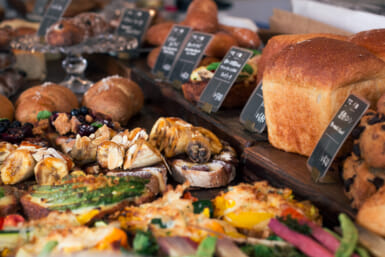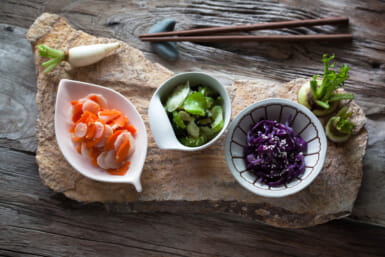Healthful Tofu: More than Soup Decoration
with Elizabeth Andoh
Perhaps one of the best known (to Westerners, that is) Oriental foodstuffs is tofu. Commonly called “bean curd” in English, the name is not only unappetizing, but incorrect.
The smooth white cake is made from the whey, not the curd, of soybean milk. Many people already know that tofu is reputed to be “good for you” and low in calories – both claims being quite accurate.
But most Westerners with little experience in Oriental kitchens are quite puzzled by tofu—besides floating cubes of it in soup, what can you do with it?
One very good use is in the making of shira ae (white dressing). Today’s recipes are for plain shira ae, and two variations on this theme using sesame seeds and walnut meats respectively. Any of these dressings will keep well for several days, if covered, in the refrigerator.
What can you dress with these dressings? The Japanese usually braise carrots, shiitake and konnyaku strips (recipe follows, under title of “gu“). Or barely boiled (in lightly salted water) green beans make a tasty and attractive alternative.
Nothing wrong with lettuce, cucumbers and tomatoes either. Experiment and have fun!
GU (“filling” of carrot, shiitake and konnyaku strips)
ingredients:
- 1 small carrot, cut in slivers (about 3/4 cup)
- 2-3 dried shiitake, softened and cut in slivers
- 1/3-1/2 cake konnyaku, cut in slivers or strips
- nijiru: 1/2 cup dashi, 2 T sugar, 3 T usugushi, shoyu
instructions:
1. Parboil carrot and konnyaku strips and drain them. Squeeze excess liquid from the softened shiitake strips.
2. Combine the nijiru ingredients in a small saucepan and bring to a boil.
3. Add the vegetable strips to the nijiru and braise until the liquid is reduced by half (the carrots should be tender but still have “bite” to them).
4. Drain the sliced vegetables and let them cool down to room temperature before dressing with shira ae.
notes:
Konnyaku (translates as the exotic “devil’s tongue root”) is gelatinous in texture, though it becomes firmer when boiled (unlike gelatine, which melts with heat). It may have an unpleasant odor before parboiling, but this will disappear with cooking. It is said that although konnyaku has almost no nutritional value, it helps to clean the intestinal tract of impurities.
* * *
SHIRA AE (white dressing)
ingredients:
- 1/2 cake of kinugoshi tofu
- 1 T. sugar
- pinch salt
- 1/4 T. usugushi shoyu
- 1/2 T. sake
instructions:
1. Roil the tofu for 2-3 minutes in rapidly boiling water. Drain the tofu in a cloth-lined colander (fine meshed linen, called sarashi is best for this and other cooking purposes such as straining soup stocks) and gently squeeze out excess
liquid, twisting the cloth as necessary.
2. Place the crumbly, rather dry tofu in a suribachi (or bowl and be prepared to use a bit of muscle) and grind until pastey. Gradually add the remaining ingredients, in order, while grinding to smoothly blend them all. The final dressing is a thick, pastey one which can be thinned out, if desired, with dashi.
* * *
SHIRA GOMA AE (white sesame dressing), a variation
Changes in ingredients:
- use 1/4 cake of tofu
- add 2 T. white sesame seeds (goma)
instructions:
1. Dry roast the sesame seeds and transfer them, still warm, to a suribachi and grind thorn to a paste.
2. Proceed as in Shira Ae recipe.
* * *
KURUMI AE (walnut dressing), a variation
Changes in ingredients:
- use 1/4 cake of tofu
- add 1/4 cup walnut meats
- add 1 1/2 T. dashi
instructions:
1. Dry roast the walnut meats (if not already purchased that way) and transfer them to a suribachi while still warm. Grind them to a paste.
2. Proceed as in Shira Ae recipe, thinning the final dressing with the dashi.
note:
Walnuts are called kurumi in Japanese.








